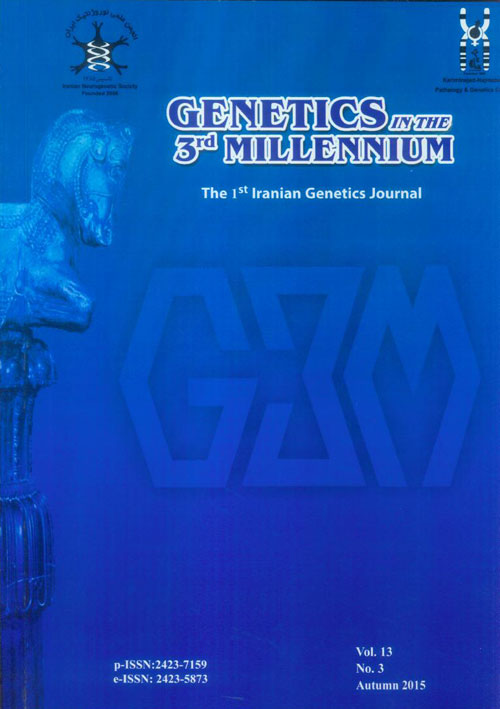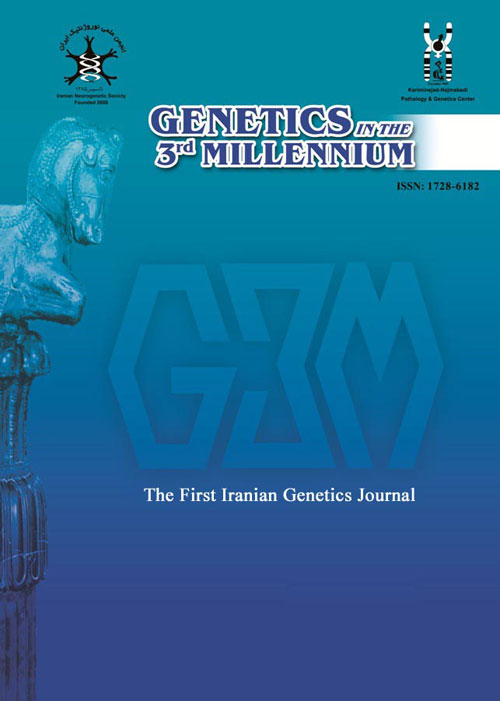فهرست مطالب

Genetics in the Third Millennium
Volume:13 Issue: 3, Autumn 2015
- تاریخ انتشار: 1394/10/30
- تعداد عناوین: 9
-
-
Pages 4030-4033Gonadal dysgenesis is a progressive congenital destructive phenomenon of the germ cells in the embryonic life that produces a fibrotic band depleted of germ cells (streak gonads) and includes pure XX gonadal dysgenesis (bilateral streak ovaries), pure XY gonadal dysgenesis or Swyer syndrome (bilateral dysgenetic testes), and mixed gonadal dysgenesis (an streak ovary and an ipislateral dysgenetic testis). In this article, we describe the aforementioned in detail and share our experience in this regard in our center with the readers.Keywords: Disorders of Sex Development, Karyotype, Gonadal Dysgenesis, Hormonal Effect
-
Pages 4034-4039Promyelocytic leukemia (PML) is one of the major proteins in the PML nuclear bodies (PML-NBs). Retinoic acid (RA) exerts its tumor growth suppressor activity and terminal myeloid differentiation of granulocyte/monocyte progenitor (GMP) cells throught PML-NBs in the RA pathway. RA acts as a natural morphogen during posterior patterning in embryo neural development. This study was aimed to define the possible PML involvemet in RA dependent neural development of human embryonic stem cells (hESCs). The expression level of PML at both mRNA and protein level was assessed by the quantitative real time RT-PCR (q-RT-PCR) and western blotting, respectively. The mRNA data showed that PML had maximum expression in pluripotent hESCs and this expression clearly decreased in neural precursor cells (hNPCs) and neural cells (hNCs). No significant differences existed between the two latter cell types at mRNA level, while protein assay showed numerous protein bands with different intensities in hESCs, hNPCs, and hNCs. The data suggest that PML may have an important role in cellular pluripotency, and PML might be necessary in cellular pluripotency and nervous system development.Keywords: PML Nuclear Bodies, Pluripotent Stem Cells, Cell Differentiation
-
Pages 4040-4045Among the lesions induced by chemotherapeutic drugs, DNA double-strand breaks (DSB) are considered the most serious ones that can result in cell death, if it is not properly repaired. Homologous recombination (HR) pathway is the main system for DSB repair and XRCC3 has a key role in this pathway. Protein activity can be affected by the XRCC3 polymorphism. Thus, in this study, the association between XRCC3 Thr241Met polymorphism and therapeutic outcomes was investigated.The study population consisted of 67 adult patients with de novo AML(range: 15-65 years). XRCC3 Thr241Met polymorphism was determined by PCR-RFLP technique. Clinical data were collected from patients’ medical records. There were no significant association between XRCC3 genotype and therapeutic outcome (P=0.764). We found no considerable correlation between XRCC3 genotype and age (P=0.255), gender (P=0.239), AML-subtype (P=0.961) as well asWBC count (P=0.629).There are only a few studies conducted on the relationship between therapeutic outcomes and XRCC3 Thr241Met polymorphism in AML patients and the reported findings are controversial. Accordingly, further studies will be required to clarify the effect of XRCC3 Thr241Met polymorphism on therapeutic outcome.Keywords: Leukemia, X-ray Repair Cross Complementing Protein 3, Polymorphism Genetic, DNA Repair, Therapeutic Outcome
-
Pages 4046-4052Ghrelin is a peptide hormone that is composed of 26 amino acids and leads to a positive energy balance and obesity through stimulation of releasing growth hormone, and increasing food intake and body weight. The purpose of this study was to determine and evaluate the association between the ghrelin gene polymorphism and growth traits in Ross and Cobb broiler chickens. Blood samples were collected from one hundred Ross and sixty Cobb chickens and their DNA was extracted using the modified salting-out chloroform method. Polymerase chain reaction (PCR) was carried out by specific primer pairs to amplify a 423bp fragment from a part of exon one and exon two of the ghrelin gene. The pattern of all samples was determined through single stranded conformation polymorphism (SSCP) analyses by Acrylamide gel using silver staining. Three different patterns were found in each strain. A, B, and C patterns with the frequencies of 0.2903, 0.4839 and 0.2258, and D, E and F patterns with the frequencies of 0.2889, 0.1333 and 0.5778 were found in Ross and Cobb strains, respectively. The associations between polymorphisms and the growth traits were evaluated using the GLM procedure of the SAS software. There was no significant association between the patterns and the growth traitsKeywords: Polymorphism, Genetic, Ghrelin, Chicken, Polymerase Chain Reaction, Polymorphism, Single, Stranded Conformational
-
Pages 4054-4061Indole acetic acid is an important hormone that improved the growth of different plant organs such as the root under normal and stress conditions. As various studies have shown, most of rhizobacteria produce indole acetic acid and thereby contribute to the growth of plants. In this study, different rhizobacteria were isolated from different regions of Iran for the assessment of their ability to produce indole acetic acid using the Salkowski method. Then, their genetic diversity was investigated using the RAPD marker. The best indole acetic acid producing Plant Growth Promoting Rhizobacteria (PGPR) was identified using 16S rRNA gene sequencing. The results showed that Ama2 strain was the best rhizobacteria for producing indole acetic acid. Investigation of the genetic diversity indicated that minimum and maximum similarity coefficients between rhizobacteria were zero and 0.53 respectively suggesting the existence of different genera between these rhizobacteria. All rhizobacteria were divided into four groups based on their genetic differences instead of their capability for producing IAA. In other words, strains with different capabilities were placed in the same group because of the existence different genera of rhizobacteria. Based on 16S rRNA gene sequencing, the superior strain belonged to the Pseudomonas genus indicating the importance of this genus for the production of indole acetic acid. The results showed that the RAPD marker and 16S rRNA gene sequencing were capable of studying the genetic diversity and identifying rhizobacteria. Moreover, Ama2 strain can be used as plant growth promoting rhizobacteria with the best capability of IAA production.Keywords: Bacteria, Indole Acetic Acids, Genetic Variation, RAPD Marker
-
Pages 4062-4067The Raini Cashmere goat is one of the Iranian goat breeds with a high economic value on international markets due to its high production and high quality. The BMP15 gene regulates granulose cell proliferation and differentiation by promoting granulosa cell mitosis, suppressing follicle-stimulating hormone receptor expression, and stimulating the kit ligand expression. This gene plays a pivotal role in female fertility in mammals and is a potential candidate gene for prolificacy in marker-assisted selection. Thus, the aim of this study was to detect the polymorphism in exon 2 of BMP15 gene and its association with the litter size (number of the offspring born per doe) in 200 Raini Cashmere goats. The genomic DNA was extracted from the whole blood. PCR products were separated on the agarose gel. Amplification products had a good specificity. The amplified fragments were digested with HinfI enzyme (PCR-RFLP) and were genotyped on the 3.5% agarose gel. Allelic frequencies were estimated as 0.7 and 0.3 for B and b alleles, respectively. The Chi-square test showed that the population was in Hardy-Weinberg equilibrium. The observed number of the alleles, the effective number of the alleles, average heterozygosity, the Nei index, and the Shannon's Information index were 2.00, 1.70, 0.41, 0.41, and 0.60 respectively showing a high genetic diversity for the BMP15 gene in the Cashmere Raini goat. For association study between the genotypes and the litter size, the GLM procedure in the SAS software was used. The results of the statistical analysis showed that the effect of the genotype on the litter size was significant (P<0.01) and the heterozygote genotypes had the highest litter size, suggesting that this polymorphism could be used as a molecular marker to improve the prolificacy in Raini Cashmere goats.Keywords: BMP15 Gene, Litter Size, Raini Cashmere Goat Fertility, Gene Frequency, Polymorphism, Genetics
-
Pages 4068-4075One of the most important goals for researchers in the clinic is to try to find newer and more effective ways to diagnose and cure the diseases. These clinical advances can create new points of view in other sciences and their combination with basic sciences such as statistics can improve these researches. In statistical genetics, linkage analysis is a way of finding the exact locus of a disease gene on a specific chromosome. Finding the location of a specific gene using the mapping strategy or producing an efficient drug for effective treatment are the most important issues in genetic fields. In this study, non-parametric methods in genetic linkage analysis will be discussed. Based on the conducted studies in different databases such as the NCBI (PubMed), Scopus, Science Direct, Google Scholar, Iran Medex, SID, and Magiran, few Iranian articles published in English language and also a limited number of Iranian investigations were found therefore, there are few studies om the combination of genetic linkage analysis and statistics in the Iranian population and the present articles in this field are scarce.This paper will be a review of the non-parametric linkage analysis. At first, the basic concepts of allele sharing identical by descent (IBD) and allele sharing identical by state (IBS) will be explained and then, nonparametric linkage analysis will be introduced. In the second step, the explained method will be compared with each other and their weaknesses and strengths will be discussed. Also, the useful software for this type of analysis will be present.Comprehensive work on this issue needs expanded efforts and expending more time.Keywords: Genetic Epidemiology, Genetic Linkage Analysis, Allele Sharing IBD, Quantitative, Dichotomous Traits
-
Pages 4076-4083Plants face many biotic and abiotic stresses at the same time during their growth under field conditions. Plants responses toward combined stresses are often more complex than their responses to one type of stress in a way that the results of these responses are called as cross tolerance. This mixture of stresses activates specific models of gene expression that causes special signaling networks and activation of some components of resistance reactions in plants like systemic acquired resistance and R-genes. Recently, because of great progresses in genetic sciences, genetic regulation of cross tolerance has gained a lot of attention and it seems that genome reprogramming influenced by combined stresses can play a special role through inducing defense responses in plants. Depending on the nature, duration, and intensity of stresses, their impacts on plants can be additive or antagonistic. Actually, a range of molecular mechanisms are activated in order to respond to a new situation. The components of these mechanisms include reactive oxygen species, hormone signaling and transcription factors. Nowadays, a great challenge in plant cross tolerance is how plants balance their resources between growth and defence against stresses. This review focuses on the responses of plants to simultaneous biotic and abiotic stresses at the molecular level and the importance of studying plant stress factors in combination.Keywords: Gene, Gene Regulation, Reactive Oxygen Species, Transcription Factors, Hormones
-
Pages 4084-4086Fryns-Aftimos Syndrome is a rare autosomal dominant disorder characterized by craniofacial signs, anterior neuronal migration disorder (pachygyria, lissencephaly), skeletal deformities and mental retardation. We describe a five-year-old boy with abnormal facial features (hypertelorism, ptosis, high arched palate), skeletal problems (short stature, short fingers, flat feet) and mild intellectual disability. Parents are not relatives and there is no similar case in family. Based on positive clinical findings Fryns-Aftimos syndrome was suspected and genetic testing of ACTB gene was performed identifying a heterozygous c.220G>A mutation. Both parents were checked and did not harbor this mutation.Keywords: Fryns, Aftimos Syndrome, Craniofacial Abnormalities, Mental Retardation


